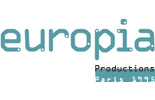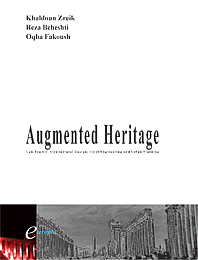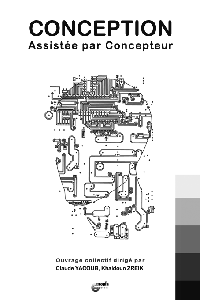
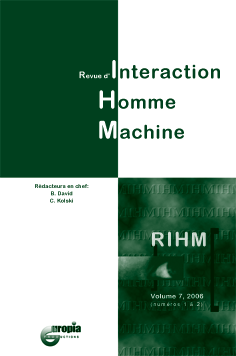
RIHM
V7
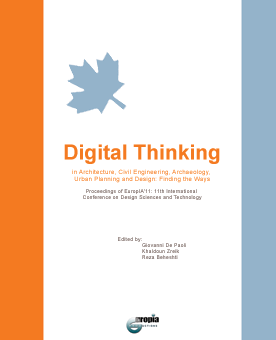
EuropIA.11
|
|
Augmented Heritage:
New Era for Architectural Design, Civil Engineering and Urban Planning
Khaldoun Zreik, Reza Beheshti & Oqba Fakoush (eds).
Europia Productions (Pub.), Paris, France (2005)
ISBN 2-909285-32-4 Price: 50 euos
|
Editorial
The span of this book covers sciences and technologies for the intelligent and reliable perception, study and use of cultural heritage that we called Augmented Heritage (AH). Being involved in a AH problematic, will imply using and adapting the hottest technologies (existing or emerging) that will enable researchers and users of cultural heritage issues to explore ‘real-virtual’ information in real-time. Moreover, we claim that Augmented Heritage is an ICT challenge. AH is a powerful and innovative learning environment in the study, presentation and understanding of cultural heritage ascertained through multi-sensory ways of technology-enhanced AH.
Augmented Heritage is the principal theme of the 10th EuropIA International Conference that focuses on the following statement:
How ICT can be used for the past to re-live and to conserve the architecture, art and culture. For instance Virtual Reality has been a powerful medium in this regard and can be much more when coupled with knowledge engineering. Contributions in this book have addressed one of the following domains:
- Theory (covering philosophy and methodologies)
- Application (scenario's, case-studies and tools)
- Education (learning and teaching to this end)
EuropIA 10 shows that dealing with Augmented Heritage concept requires the involvement of various disciplines: Archaeological Study, Architecture Design, Building Construction, Civil Engineering, Ecology, Economy, Environment, Sociology, Software Engineering, Sustainable Design, Sustainable Development and Urban Planning. Although all these disciplines have not been represented directly, they are omnipresent in several papers and often in the round-table discussions of the conference.
Application of advanced technologies in Augmented Heritage is the main goal of this conference. The multidisciplinary contributions have been focused on the following topics: Archiving, Computer Graphics, Documentation, eBook, Information Retrieval, Knowledge Representation, Machine Learning, Modelling Approaches, Multimedia, Pattern Recognition, Perception, Reconstruction (2D, 3D), Virtual Library, Virtual Reality, etc.
In sum, ‘Toward a Heritage Mining’ is the key issue of Augmented Heritage. Achieving this goal requires high level of experimental analysis approaches built upon a synthesis of multidisciplinary know-how and knowledge.
The host of the 10th EuropIA International Conference is the University of Damascus in Syria (13-15 September 2005). EuropIA.10 follows the path of a successful tradition of international platforms that since 1988 have dealt with all issues related to design sciences and technology. Previous conferences have been: EuropIA 1 (1988, Paris, France), EuropIA 2 (1990, Liége, Belgium), EuropIA 3 (1991, Athens, Greece), EuropIA 4 (1993, Delft, Netherlands), EuropIA 5 (1995, Lyon, France), EuropIA.6 (1997, Edinburgh, United Kingdom), EuropIA 7 (1998, Paris, France), EuropIA 8a & EuropIA8b (2001, Delft, Netherlands) and EuropIA 9a & EuropIA 9b (2003, Istanbul, Turkey).
The EuropIA Conferences are organized as a cross-platform for the study and analysis of the application of the information, communication and computer technologies to architecture, archaeology, building engineering, civil engineering, urban design and policy analysis. What makes this conference unique is the interaction of different disciplines regarding their approach, methods and techniques for the application of advanced technologies. Specifics of disciplines are not the subject of the conference but serve as cases. Cross-platform discussions and interactions help to enhance scope of these technologies beyond their existing application limits. Furthermore, we seek a discussion of terms and conditions for introducing new tools (offered by the latest technology developments) and new strategies (required by the inevitable changes of the professional and educational working environments of architecture, archaeology, building engineering, civil engineering, urban design and policy analysis).
We would like to thank all who, in one way or another, directly or indirectly, were involved in this conference. Particularly we express our gratitude to authors of all papers appearing in this book, members of EuropIA 10 Scientific and Organising Committees, University of Damascus (Syria), University of Caen (France), Delft University of Technology (Netherlands), Nosstia (Syria), The Arab School for Sciences and Ecology (Syria), Design Research Foundation (Netherlands) and europia Productions (France).
Khaldoun Zreik
Reza Beheshti
Oqba Fakoush
|
Table of Contents
Editorial
Khaldoun Zreik, Reza Beheshti and Oqba Fakoush
Augmented Heritage: A Sustainable ICT Challenge
Khaldoun Zreik and Reza Beheshti
Prodomea IT Tool
Antonella Grossi, José Delgado Rodrigues, Talal Akili, Angela Chahoud, Andrea
Bulgarelli and Mouffak Doughman
Fusing Laser Scanning and Photogrammetry Creating Close Range
Architectural Orthoimages
Bjorn van Genechten and Herman Neuckermans
MArCo: A Knowledge-Based Architectural Reconstruction System for Hypothesis Testing
Didier Boucard
Extracting and Exploring Aggregates of Web Documents with Experimental Visualisation Tools
Franck Ghitalla, Fabien Pfaender and Camille Maussang
ICT and the Ancient City of Byblos: A New Direction for the Communication of Intangible Heritage
Giovanni de Paoli and Nada El-Khoury
Digital Historical Reconstruction: Case Studies of an Interdisciplinary
Task
Han Vandevyvere, Herman Neuckermans and Krista De Jonge
Optimization of Repetitive Cycles on Building Sites with Genetic Algorithms
Hind Aljazaerli and Jean Claude Mangin
What Can Cognitive Science Bring To Design Computing?
John Gero
Spatiality and Virtuality: Perception Virtual Urban Environments
Mohamed Alaa Mandour
Creating Constructive Online Educational Environment
Mona Abdel Fattah Younes
Interactive installations on the threshold of built heritage
Nadia Mounajjed, Chengzhi Peng and Stephen Walker
NGI Technologies for the Integration and Presentation of Construction Management Information
Edwin Dado, Reza Beheshti and Hennes de Ridder
Integration of Uncertainties in the Assessment of Green Buildings
Reem Essa, Youssef Diab and Denis Morand
The Use of ICT to Support Urban Heritage Appraisal
Rima El Hassan and Hisham Elkadi
Revival of Courtyard’s Type through Sustainable Mixed-Use Buildings …
Roula Ntefeh, Christian Marenne and Daniel Siret
Building Design Using Geometrical Patterns
Sevil Sariyildiz
A Comparative Study in Using Virtual Environments for Urban Daylight Analysis
Souha Tahrani, Guillaume Moreau and Philippe Woloszyn
The Living Archive
Urs Hirschberg, Christian Fröhlich, Wenzel Wondra and Ulrich Reiterer
Three Layered Agents Evaluators for Three Layered Structural Optimisation Problems in A Multi Agents Structural Tool ………………
Cherif Branki, Tilmann Bitterberg, Alan Bridges, Adam Borkowski and Ewa Grabska
Applying Genetic Algorithms for Optimisation of Repetitive Activities Scheduling Mohammed Al Joma and Jean-Claude Mangin
|
|
